See also: “Methodology for ‘The Cost of Child Care During the Coronavirus Pandemic’” by Simon Workman
As the nation continues to grapple with the challenge of the coronavirus pandemic, child care is among the hardest-hit and least supported industries. Parents have long struggled to find and afford child care that meets their needs; and child care businesses have equally struggled to balance the cost of providing quality, developmentally appropriate care with the limited revenues available to them.1 Now, the pandemic has exacerbated the existing child care crisis and raised significant new challenges. Many child care programs were forced to close for a period of time, and while many have since reopened, they are operating with decreased enrollment and increased instability due to the ongoing impacts of the pandemic.2 This new reality poses a dire threat to many child care programs, which were already operating on razor-thin margins and lack the financial reserves to weather the current crisis.
While the Coronavirus Aid, Relief, and Economic Security (CARES) Act, passed by Congress in March 2020, provided states with $3.5 billion through the Child Care and Development Block Grant to support access to child care, this level of funding is woefully insufficient to meet the ever-growing need.3 Recognizing this shortfall, in July 2020, the U.S. House of Representatives passed on a bipartisan vote the Child Care Is Essential Act, which would provide a $50 billion investment to stabilize the industry.4 However, as of August 2020, the Senate has failed to act on this bill or to appropriate significant additional funds for child care in a new stimulus package. Meanwhile, child care businesses continue to serve the children of essential workers and others who rely on child care to work. However, without significant federal investment, half of America’s child care capacity is at risk of permanent closure.5 This would have a catastrophic impact on the American economy, jeopardizing thousands of child care jobs, leaving millions of children without access to child care, and plunging parents and employers into turmoil as they continue to juggle work and family responsibilities.
Despite the critical role of child care in supporting the economy, there is a lack of clear understanding as to what it really costs to provide quality child care—particularly as child care programs face new guidelines and challenges responding to the COVID-19 pandemic. To address this, the Center for American Progress has developed an interactive calculator that estimates the cost of providing child care that meets pandemic-related state guidelines.6 Initial analysis finds that providers are facing, on average, a 47 percent increase in operating costs during the pandemic, with even higher increases for programs serving 3- and 4-year-olds.
These data underscore the need for immediate federal investment in child care to ensure that providers can meet these additional costs, stay open, and provide safe care for the millions of children and families who rely on it. As states grapple with the economic fallout of the pandemic and the need to balance their budgets, the federal government must step in and provide the funds necessary to support access to child care. Beyond the immediate needs related to the pandemic, policymakers should prioritize long-term funding for child care, recognizing the role the industry plays as the backbone of the economy. Robust public investment is needed to address the inequities in access to child care that have long existed and to fill the gap between what parents can afford to pay and the true cost of providing child care, including a living wage for early childhood educators.
Estimating the cost of child care during the pandemic
The child care market has long been broken. Most parents cannot afford the true cost of quality child care that adequately compensates teachers, and public subsidies designed to help working families access child care are limited in scope and insufficient in funding.7 In 2018, CAP developed an online interactive to help better understand the true cost of providing high-quality center-based child care, highlighting the gap between available revenues and expenses.8 While it is commonly understood that providers are facing increased expenses as they respond to the pandemic, few studies have attempted to quantify these costs.9 As states enact the necessary emergency public health regulations to ensure that children are safe in child care settings during this time, it is critical that they understand the financial impact of these requirements and provide sufficient supports to help programs meet them.

Click the image above to view the interactive and see estimates for each state.
CAP’s new interactive calculator estimates the additional expenses incurred by providers who are operating under state emergency child care licensing requirements put in place to respond to the pandemic. The calculator is informed by state requirements and includes several default variables related to staffing patterns, salaries, and additional sanitation costs. Given the ever-changing nature of the pandemic and state responses to it, users can also override these variables to create a custom model based on the latest requirements. Full details of the assumptions in the calculator can be found in the methodological appendix.10
The calculator can be used to better understand the increased costs of providing care during the pandemic in both child care centers and family child care homes. It also shows how these costs vary when early childhood educator pay is increased beyond the current, unacceptably low level. Finally, the calculator can be used to estimate the statewide costs of supporting the child care industry during this time, helping state policymakers as they seek to understand the resources needed to ensure the survival of a critical part of their economic infrastructure.
The true cost of child care has increased 47 percent during the pandemic
Using default data embedded in the calculator, initial analysis finds that the cost of center-based child care that meets enhanced health and safety requirements is, on average, 47 percent higher than the cost of meeting pre-pandemic requirements. This is driven primarily by a reduction in program capacity due to physical distancing requirements and by the need to purchase additional sanitation supplies. Meanwhile, the cost of home-based family child care is 70 percent higher than it was before the pandemic. Tables A1 and A2 in the Appendix provide data on the average increased cost in each state.11
Within this average, the calculator provides data broken down by age. While infant child care remains the most expensive age group, it is the classrooms for 3- and 4-year-olds that see the biggest increase in cost—due to the significant decrease in group size that is necessary for these age groups. Figure 1 below shows the average cost by age group. Notably, family child care homes are not broken down by age group; since they usually operate as single classrooms, different ratios and group sizes are not built into the calculator by default. Table A3 in the Appendix shows the breakdown by age for each state.
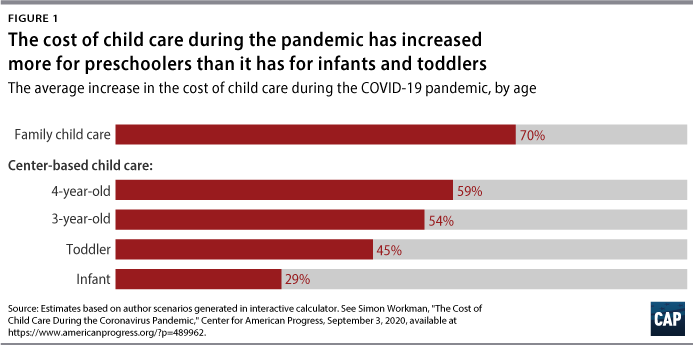
Group size and ratios
The variations in data between states is driven primarily by the group size limitations that many, but not all, states imposed in response to the coronavirus pandemic. While many states have limited group size to no more than 10 children per classroom, others have offered no guidance to limit class size, or have only made recommendations, rather than enact new emergency public health regulations. The data in the calculator are based on the most restrictive requirements put in place by the state as of July 2020. For example, if a state enforced a limit of 10 children per classroom in April, but as of September, they reverted back to regular licensing standards, the calculator would use the limit imposed in April as the default for the coronavirus scenario. Users can modify the defaults in the calculator to account for the current requirements at the time of use or to reflect actual practice by providers in states that have no mandated smaller group sizes.
To help states understand the resources needed to support child care providers during the pandemic, the calculator also includes data estimating the statewide costs of child care. Many providers had to temporarily cease operations during the worst of the pandemic or are facing rolling closures in response to localized outbreaks. While these providers are closed, it is important that they continue to receive support to cover at least their fixed operating costs so that they can survive the closure and be ready to reopen when conditions improve. The calculator uses data from CAP’s child care deserts database of licensed child care providers to estimate the cost of covering the fixed expenses of a user-specified percentage of child care providers in each state.12 In addition, the calculator can be used to estimate the cost of covering the total operating costs of a user-specified percentage of child care slots in each state. As policymakers increasingly recognize the value of child care and discussion of child care as a public good intensifies, states can use the calculator to estimate the cost to provide child care—at no cost to families—for all essential workers in the state.13 Table A4 in the Appendix provides an example of these costs for each state, based on covering the fixed expenses of 20 percent of providers and the operating costs of 40 percent of total state capacity.
What drives the higher cost of care?
The largest expense for a child care program is the cost of paying staff. Even though the average early childhood educator makes only slightly more than $12 an hour, personnel expenses account for approximately 70 percent of a child care provider’s total budget.14 Personnel costs have continued at the same level, or even increased, during the pandemic, as child care centers have been unable to maintain ratios by having “floating” staff that move between classrooms and are now required to have fully dedicated staff for each classroom instead. In addition, most providers are requiring parents to drop off their children at the entrance to the building, rather than walk them to the classroom. This requires additional staffing to manage the new pickup and drop-off procedures, such as taking temperature checks or asking parents or guardians health screening questions. As providers seek to support the emotional health of the children in their care, they might also consider increasing access to mental health specialists to support children during the pandemic, especially those whose parents are working on the frontlines of the COVID-19 crisis.
In addition to staffing costs, providers are spending more on sanitation supplies. While child care centers and family child care homes have always had high sanitation standards, the calculator includes additional expenses for personal protective equipment such as masks and gloves, thermometers for temperature monitoring, and additional hand sanitizer and disinfectant. The calculator also includes the cost for a weekly deep cleaning of the program. Figures 2 and 3 show the breakdown of expenses in the default scenarios presented in the calculator—before and during the pandemic—for child care centers and family child care homes.
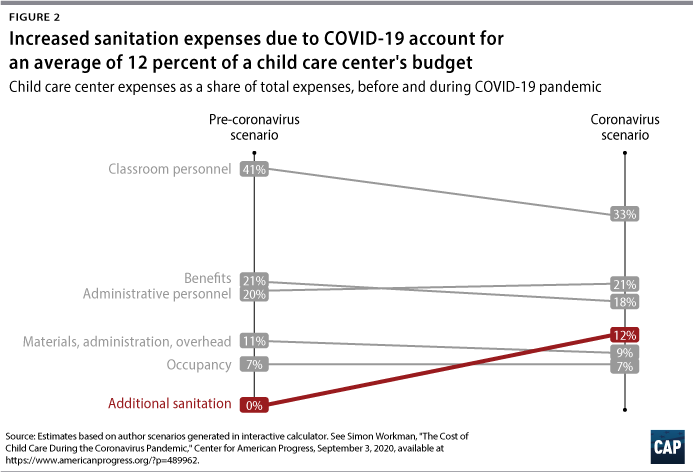
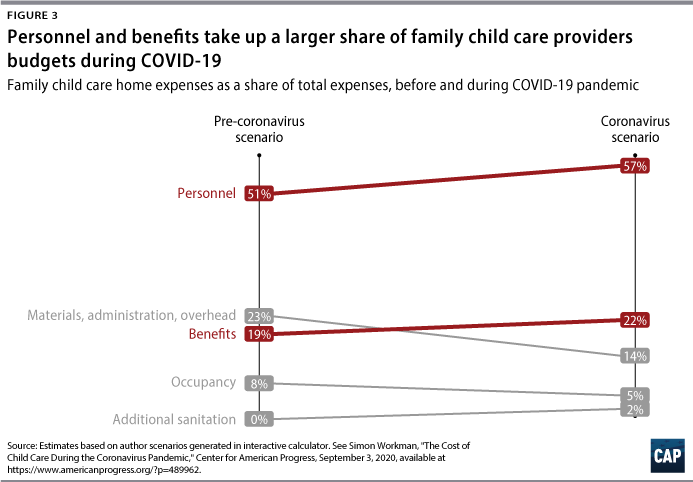
Early childhood educators are often paid only slightly more than minimum wage, and many rely on public assistance.15 While this has always been unacceptable given the important role that they play in the development of young children, it is even more alarming when considering the essential role that this workforce is playing during the pandemic. Thousands of early educators—primarily women, and often women of color—are putting themselves and their families at risk by continuing to work during the pandemic in order to ensure that care can be provided to families who do not have the option of working remotely during this time. Family child care providers may be particularly vulnerable since they are inviting children into their own homes where they and their families eat, sleep, and play. The lack of health insurance benefits offered in many programs puts educators further at risk. To address this inadequacy, the calculator includes health insurance by default and also includes an option to estimate the cost of care in a scenario in which employees are receiving higher salaries. In this way, states can better understand the true cost of providing care that meets both families’ and early educators’ needs.
Covering the higher cost of care during the pandemic
The increased costs of providing child care during the pandemic are too high for providers to shoulder on their own and beyond what most families can afford. Even before the pandemic, working parents were struggling with the high cost of child care.16 Child care subsidies, intended to support access to child care for working families, reach fewer than 1 in 10 eligible children in most states—despite low eligibility limits—and fail to reimburse providers at the true cost of providing quality care.17 Meanwhile, the majority of families are left to pay for child care on their own, facing prices that rival the cost of college tuition and that often exceed the cost of their mortgage or rent.18 The result is an insufficient supply of child care in many communities, especially lower-income neighborhoods. This leaves families scrambling to put together a patchwork of care that they can afford and that meets their needs—but that too often still leaves them struggling to maintain stable employment.19
To help providers maintain operations throughout the pandemic, many states have used funding from the CARES Act to help offset their increased costs and have modified subsidy policies to provide payments based on enrollment rather than attendance.20 However, data from this calculator show that much more funding is needed, with the CARES Act estimated to only cover the cost of 30 percent of child care slots for one month. While child care providers were eligible for the Paycheck Protection Program, data from the Bipartisan Policy Center finds that only 6 percent of providers were able to access this program, receiving less than 5 percent of the total funds distributed.21 Even for those who did receive a loan, the impact of the pandemic is likely to be felt long beyond when these funds are fully expended. Without significant federal investment to help cover the increased costs of care, there will only be more stories of providers closing their doors for good.22 When the pandemic has passed and offices are open once again, this crisis will be evident for all. An increased number of parents will find themselves in a child care desert with severely limited options for licensed care, and businesses will find themselves with a workforce unable to work.
Conclusion
Child care is a necessity for working families. This was true long before the pandemic but has become even more clear as families juggle the demands of work while dealing with school and child care closures. Without child care, parents cannot work and the economy cannot return to normal. However, many child care programs are at risk of permanent closure as they struggle to budget for increased expenses and decreased revenue. In order to save the child care market, significant public investment is needed—both in the short term to meet the increased costs of new health and safety protections and to stabilize the industry and in the long term to ensure a comprehensive early childhood system that meets the needs of children, families, early childhood educators, and businesses.
The Child Care Is Essential Act and the Child Care for Economic Recovery Act, passed by the U.S. House of Representatives in July 2020 but not picked up by the Senate, would inject more than $50 billion into the child care industry, ensuring its survival throughout the pandemic. While airlines and other industries have received bailouts to weather the current storm, child care providers have once again been undervalued and largely left to fend for themselves. In the long term, a comprehensive solution such as the Child Care for Working Families Act would provide stable and sufficient funding for child care, ensuring that families can afford care that meets their needs and that educators are fairly compensated.
While federal funding is necessary to provide the level of resources needed to save the child care industry, states must also preserve their current investments in early care and education despite the budget shortfalls they are facing. Investments in early childhood provide lifelong dividends, for children, for families, and for state economies. In recent years, many states have made admirable investments in their early learning systems. Now, as they look to balance their budgets, states must not do so on the backs of young children, working families, and early childhood educators.
The impacts of the coronavirus pandemic have been severe for millions of businesses across the country. But the child care industry has been hit particularly hard. As the data in this report show, without significant investment, the industry will collapse. While the majority of child care providers are private businesses, the service they provide is a public good. Not only are they a key part of the infrastructure that supports the current U.S. workforce, but they also play a significant role in shaping the future workforce, harnessing the potential of young children during a critical period of brain development and setting them up for a lifetime of learning and social interaction. Nothing less than the future economic prosperity of the United States is at risk if we fail to support child care providers and educators throughout the pandemic and beyond.
Simon Workman is the director for Early Childhood Policy at the Center for American Progress. Steven Jessen-Howard is a former research assistant for Early Childhood Policy at the Center.
Acknowledgments
The authors wish to thank Mat Brady and Bill Rapp for their assistance developing the interactive calculator, as well as MK Falgout and Cristina Novoa for their assistance analyzing the data that inform this issue brief.
Appendix
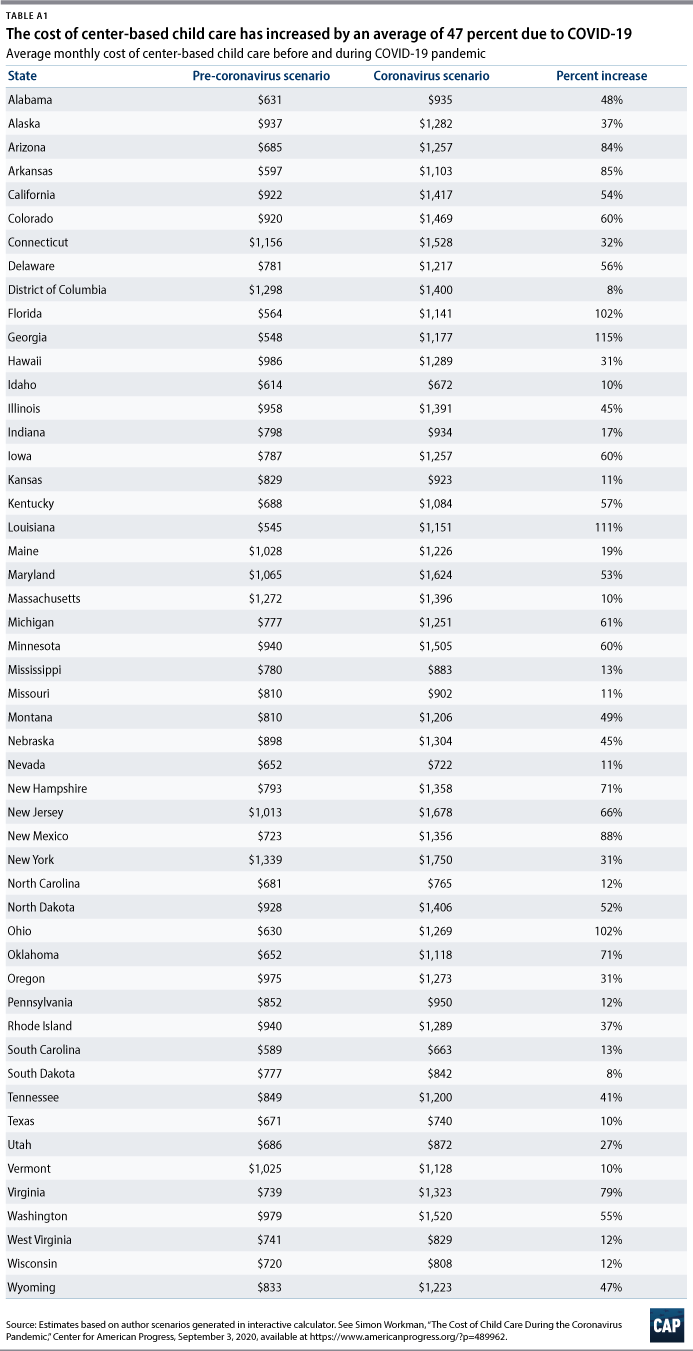
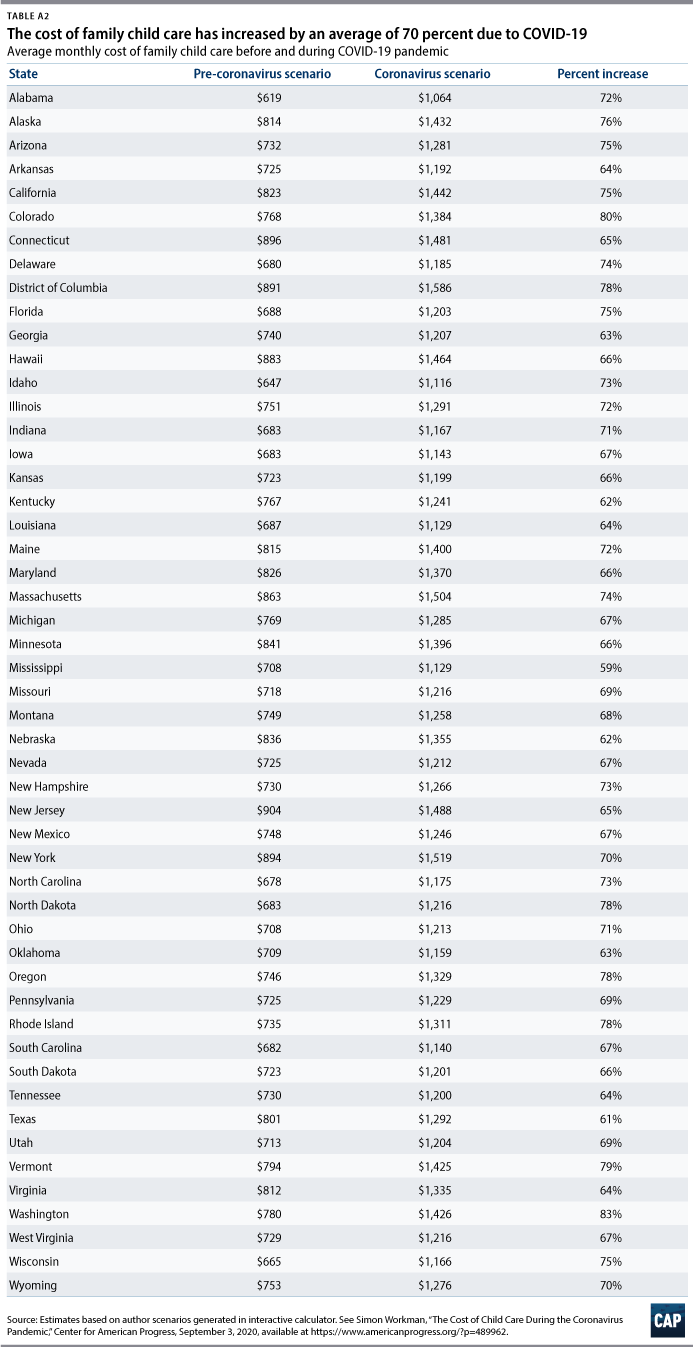
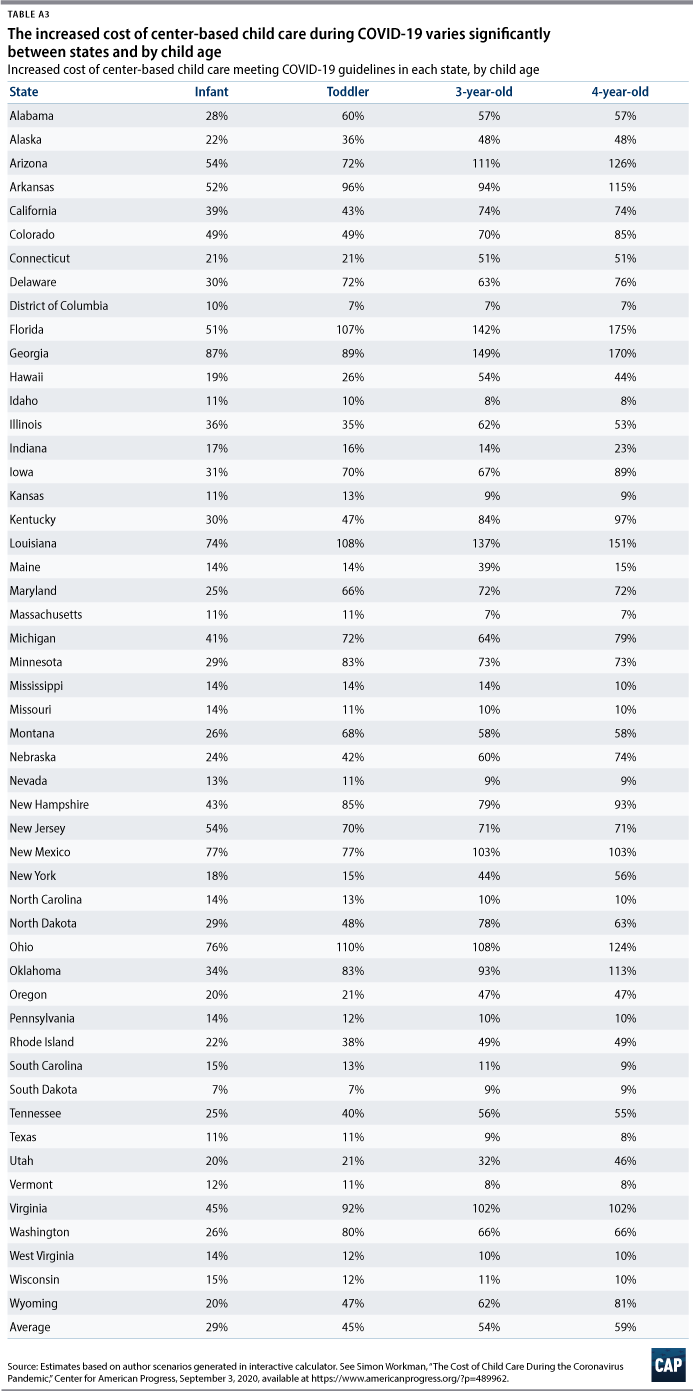
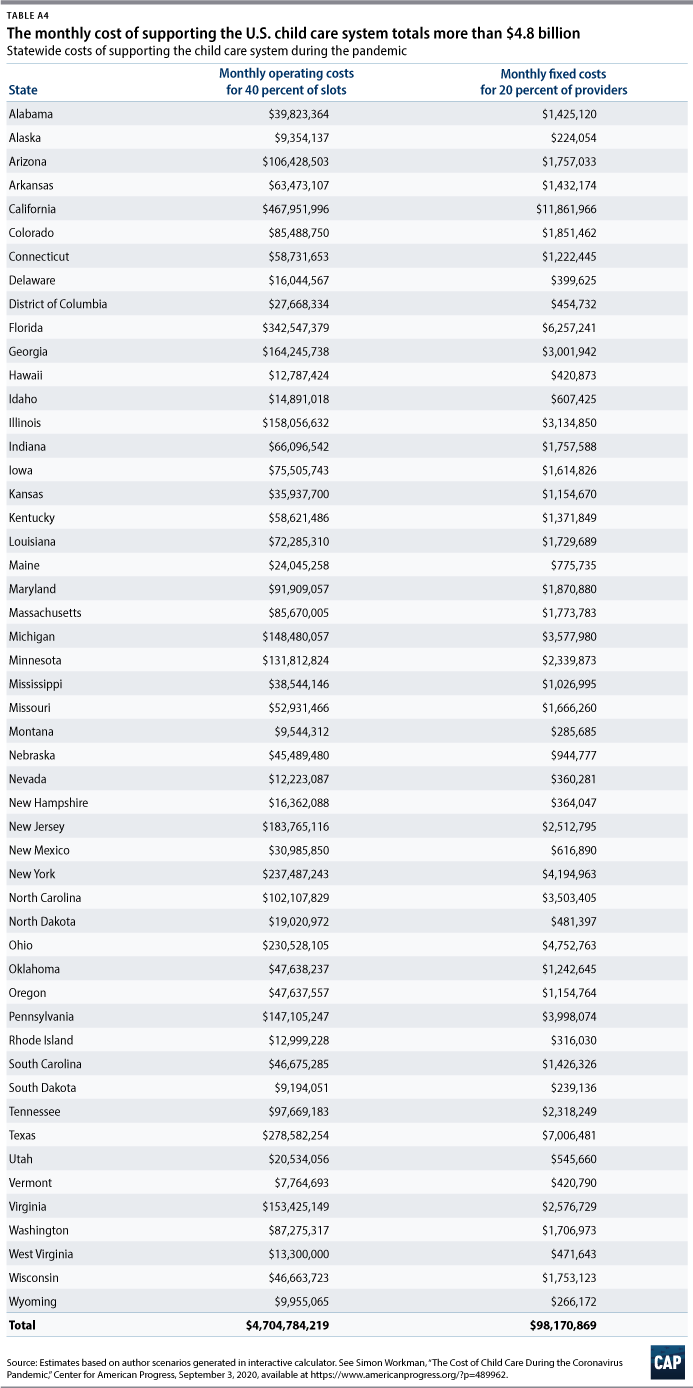
To find the latest CAP resources on the coronavirus, visit our coronavirus resource page.